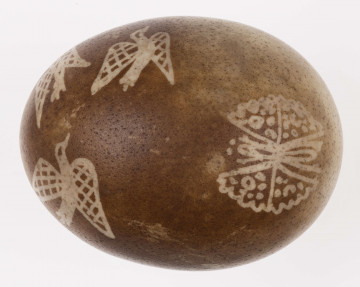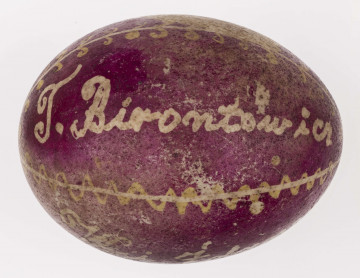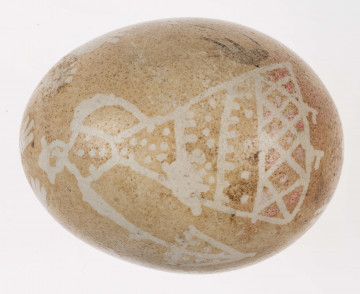
Easter egg
1901 — 1920
National Museum in Lublin
Part of the collection: Folk craft of the Lublin Region (19th/20th c.)
The essence of a toy has not changed for many generations. It is meant to entertain and help a small person learn about the world. One of the oldest, and certainly a child's first toy, is a rattle. It is by playing with rattles that the youngest have been learning to distinguish between a clatter and a rattle or bell and to locate the source of the sound in space. Rattles help to develop the sense of touch and learn about the properties of the plastic or material they are made of, i.e., hardness, texture or shape.
Special toys that make sounds were given to children at Easter. They were usually bought at pre-Easter stalls. These were: knockers, clatters, rattles, magpies and ticklers, known in various forms in all Slavic countries, Western Europe and Asia. In Poland, they were already toys in the 17th century. In his Description of Customs During the Reign of Augustus III, the Reverend Jędrzej Kitowicz mentioned the sound of wooden knockers, which replaced church bells at the end of Lent: ‘[...] the rattles began on Maundy Thursday and ended on Holy Saturday and lasted for the time that the church does not use bells for ringing, only clappers for tolling. As soon as the clappers sounded in the church tower, the boys immediately ran through the streets with their rattles, making an unpleasant noise in the ears of passers-by’. They ran around with their rattles and knockers, scaring others and playing tricks. This was also a way of warning of Lent, warding off evil and protecting people and animals from dangerous and pernicious forces. It was related to pre-Christian beliefs, when the period of today's Easter was one of the cycle of festivals celebrated by the Slavs in honour of the dead, who as ghosts – not always good – returned for a short time among the living.
Clatters, called ‘terkotka’, had been used in Slavic lands to give signals over long distances and to scare off wild animals destroying spring crops and later harvests. Children with rattles, knockers and other noise-making instruments would run to ‘wake up’ nature with their noise, so that everything would turn green and blossom at Christmas and in spring. Similarly, they were ordered to ‘thunder’ into the ears of cows and rams in the cowshed.
Author / creator
Dimensions
cały obiekt: height: 11 cm, width: 22 cm
Object type
a toy
Technique
own
Material
wood
Creation time / dating
Creation / finding place
Owner
The National Museum in Lublin
Identification number
Location / status

1901 — 1920
National Museum in Lublin

1901 — 1920
National Museum in Lublin

1901 — 1920
National Museum in Lublin
DISCOVER this TOPIC
National Museum in Szczecin
DISCOVER this PATH
Educational path